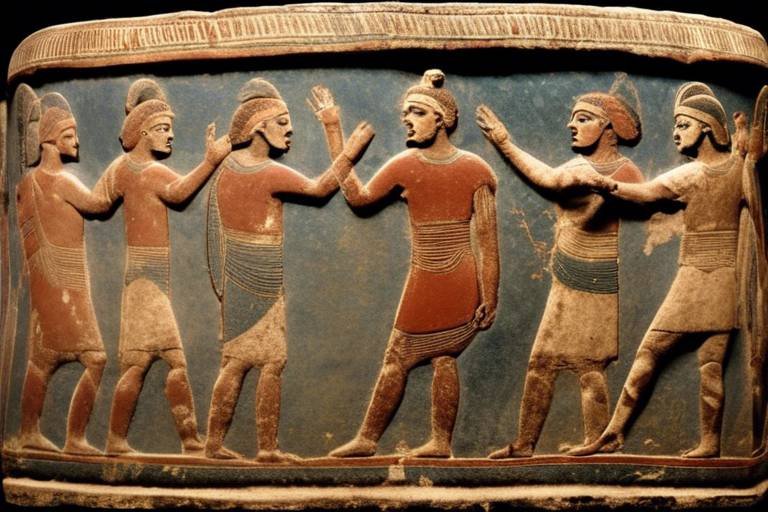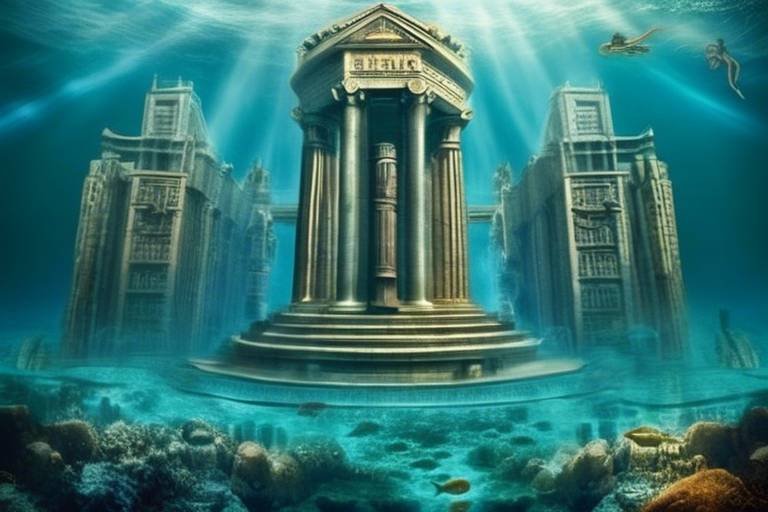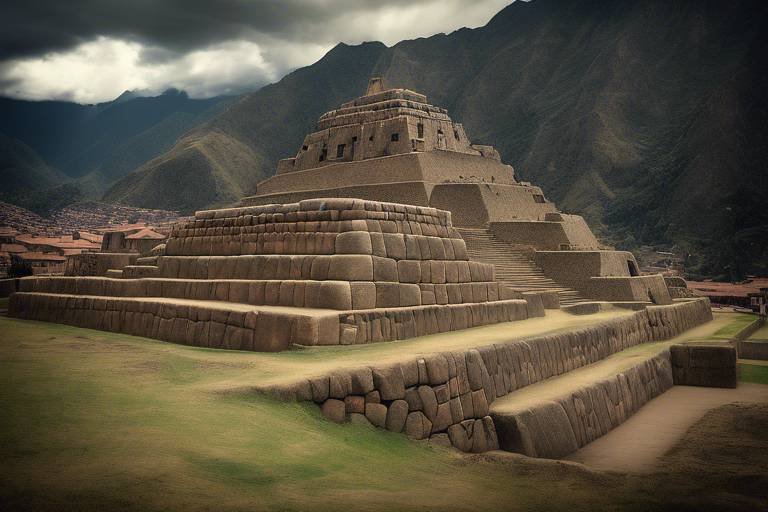The Cultural Dynamics of the Olmec Civilization
The Olmec civilization, known as one of the earliest Mesoamerican societies, captivates historians and archaeologists with its rich cultural tapestry. From their astonishing artistic achievements to their intricate religious beliefs, the Olmec people left an indelible mark on history. Let's delve into the fascinating cultural dynamics that defined the enigmatic Olmec civilization.

Artistic Achievements
The Olmec civilization is widely celebrated for its remarkable artistic achievements, which continue to captivate scholars and art enthusiasts alike. Among the most iconic creations of the Olmec are the colossal stone heads, massive sculptures that stand as testaments to their craftsmanship and artistic prowess. These imposing stone monuments, some weighing several tons, showcase the Olmec's mastery of sculpting and engineering, leaving modern observers in awe of their monumental scale and intricate details.
In addition to the renowned stone heads, the Olmec were also skilled artisans in working with jade, a precious stone highly valued by ancient Mesoamerican cultures. Their jade artifacts, intricately carved and polished, reveal a sophisticated understanding of lapidary techniques and a deep appreciation for the beauty of this precious material. From ceremonial masks to figurines, the Olmec's use of jade in their artistry reflects their reverence for spiritual symbolism and aesthetic excellence.
Moreover, the artistic style of the Olmec is characterized by distinctive features that set their work apart from other ancient civilizations in Mesoamerica. The use of abstract forms, exaggerated facial features, and symbolic motifs in Olmec artistry demonstrate a unique artistic vision that transcends mere representation, delving into the realm of spiritual expression and cultural identity.
Symbolism played a significant role in Olmec art, with many of their creations imbued with symbolic meanings that conveyed spiritual beliefs, social values, and mythological narratives. The intricate designs found on pottery, figurines, and architectural elements reflect a rich tapestry of cultural symbols and iconography, inviting interpretations that unravel the mysteries of Olmec cosmology and worldview.

Religious Beliefs
Religious beliefs held a profound influence on the Olmec civilization, shaping their worldview and daily practices. The Olmec people worshipped a pantheon of deities, with prominent figures like the Maize God and the Feathered Serpent playing crucial roles in their religious rituals and ceremonies. These divine beings were often depicted in art and sculpture, symbolizing fertility, abundance, and protection. The Olmec's religious practices involved elaborate ceremonies, offerings, and sacrifices to appease the gods and ensure the well-being of their community.
The Olmec's architectural marvels, such as the pyramids and temples, served as sacred spaces for conducting religious ceremonies and connecting with the spiritual realm. These monumental structures reflected the Olmec's reverence for the divine and their belief in the afterlife. The intricate carvings and inscriptions found on these buildings provided insights into their religious beliefs and mythological narratives, illustrating a complex cosmology that governed their society.
Furthermore, the Olmec practiced divination, using methods like the casting of lots or interpreting natural phenomena to communicate with the supernatural forces and seek guidance for important decisions. Priests and shamans played pivotal roles in mediating between the human and divine realms, interpreting omens, and conducting rituals to maintain harmony with the spiritual world. The Olmec's religious beliefs permeated every aspect of their lives, influencing their art, architecture, governance, and social interactions.

Social Structure
The social structure of the Olmec civilization was intricately woven, reflecting a hierarchical society with distinct roles and responsibilities. At the pinnacle of the social hierarchy were the rulers, often depicted in art and revered as divine figures. These leaders wielded political power, oversaw religious ceremonies, and symbolized the connection between the earthly realm and the spiritual world.
Beneath the rulers were the priests, who played a crucial role in mediating between the people and the gods. They conducted rituals, interpreted omens, and maintained the religious calendar. The priests held significant influence in Olmec society, guiding both spiritual practices and political decisions.
Artisans and craftsmen occupied another essential tier in the social structure, showcasing their skills in creating intricate jade carvings, pottery, and other artifacts. Their craftsmanship not only served practical purposes but also held symbolic and religious significance, reflecting the Olmec's artistic prowess and cultural sophistication.
Furthermore, farmers formed the backbone of Olmec society, cultivating crops such as maize, beans, and squash to sustain the population. Their agricultural knowledge and labor were vital for the civilization's sustenance, highlighting the importance of food production in the Olmec economy.
Within this social framework, each member had a specific role to play, contributing to the overall functioning of the civilization. The interconnectedness of rulers, priests, artisans, and farmers created a cohesive society where religious beliefs, artistic expression, and agricultural practices intertwined to form the fabric of Olmec culture.

Technological Advancements
The Olmec civilization was not only known for its artistic achievements but also for its remarkable technological advancements. Among their many innovations, the Olmec excelled in various fields such as agriculture, architecture, and pottery, showcasing their ingenuity and advanced knowledge.
One of the notable technological advancements of the Olmec was their expertise in agriculture. They developed sophisticated irrigation systems that allowed them to cultivate crops efficiently, contributing to their thriving economy and sustenance of their population. Additionally, the Olmec were pioneers in the cultivation of maize, a staple crop in Mesoamerican societies.
Furthermore, the Olmec made significant strides in architecture, constructing impressive ceremonial centers and monumental structures. Their architectural achievements, such as the construction of pyramids and platforms, reflect their advanced engineering skills and knowledge of spatial planning.
In the realm of pottery, the Olmec were known for their exquisite ceramic vessels adorned with intricate designs and symbolic motifs. They mastered the art of pottery-making, utilizing various techniques to create functional and aesthetically pleasing vessels that served both utilitarian and ceremonial purposes.
Moreover, the Olmec were innovators in the processing of rubber, a material derived from the latex of the rubber tree. They developed techniques to extract rubber and transform it into various products, including balls used in ceremonial ball games. This technological advancement not only facilitated trade but also played a significant role in their cultural practices.

Trade and Exchange
Trade and exchange were vital components of the Olmec civilization, facilitating connections with distant regions and enabling the flow of goods, ideas, and cultural influences. The Olmec engaged in a complex network of trade routes, exchanging commodities such as jade, obsidian, pottery, and agricultural products with neighboring societies.
One of the key trade commodities of the Olmec was jade, a precious stone highly valued for its symbolic significance and aesthetic appeal. The Olmec artisans crafted intricate jade artifacts, which were traded across Mesoamerica, showcasing their advanced craftsmanship and artistic skills.
Moreover, the exchange of agricultural products played a crucial role in sustaining the Olmec economy. The fertile lands of the Olmec heartland allowed for the cultivation of maize, beans, squash, and other crops, which were traded for different goods with regions lacking such resources.
Through trade, the Olmec not only acquired exotic materials and resources but also established cultural connections with diverse communities. This cultural exchange influenced the artistic styles, religious practices, and societal norms of the Olmec, enriching their own culture and fostering innovation.

Legacy and Influence
The legacy of the Olmec civilization extends far beyond their physical existence, leaving an indelible mark on the cultural landscape of Mesoamerica. Despite the enigmatic nature of their decline, the Olmec's influence reverberates through time, shaping the development of subsequent civilizations in the region.
One of the most significant aspects of the Olmec legacy is their artistic style, characterized by the iconic colossal stone heads and intricate jade figurines. These masterpieces not only showcase the artistic prowess of the Olmec but also served as inspiration for later Mesoamerican cultures, influencing the artistic traditions of the Maya and Aztec civilizations.
Furthermore, the religious beliefs and practices of the Olmec had a lasting impact on the spiritual landscape of Mesoamerica. The worship of deities such as the Maize God and the Feathered Serpent transcended the boundaries of the Olmec civilization, becoming integral parts of the belief systems of subsequent cultures in the region.
The Olmec's sophisticated social structure, characterized by distinct social classes and specialized roles, laid the foundation for the hierarchical societies that followed. The prominence of rulers, priests, and artisans within Olmec society set a precedent for the power dynamics and social organization of future Mesoamerican civilizations.
Moreover, the technological advancements pioneered by the Olmec, such as the development of rubber processing and advanced agricultural techniques, revolutionized the way in which subsequent societies interacted with their environment. The innovative spirit of the Olmec paved the way for further technological progress in Mesoamerica.
Overall, the legacy of the Olmec civilization serves as a testament to their enduring influence on the cultural, artistic, and technological development of Mesoamerica. By unraveling the mysteries of the Olmec civilization, we gain valuable insights into the rich tapestry of Mesoamerican history and the interconnectedness of ancient cultures.

Archaeological Discoveries
The Olmec civilization, one of Mesoamerica's earliest, holds a significant place in history. This article explores various cultural aspects of the Olmec people, shedding light on their art, religion, societal structure, and lasting influence on future civilizations.
Excavations at Olmec sites have unearthed valuable artifacts, structures, and evidence that provide clues about their daily life and cultural practices. These discoveries have been instrumental in piecing together the puzzle of the Olmec civilization. Among the most notable findings are the colossal stone heads, which stand as iconic symbols of Olmec artistry and skill. These massive sculptures, carved from basalt rock, depict distinct facial features and elaborate headdresses, offering insights into Olmec aesthetics and craftsmanship.
Additionally, archaeologists have uncovered intricate jade figurines, pottery vessels, and ceremonial objects, revealing the Olmec's expertise in working with various materials. The presence of elaborate tombs and burials suggests a complex funerary tradition, shedding light on their beliefs regarding the afterlife and ancestral veneration.
Furthermore, the discovery of architectural remains, such as ceremonial centers, pyramids, and ball courts, showcases the Olmec's architectural prowess and urban planning. These structures not only served as religious and administrative hubs but also as symbols of power and social organization within Olmec society.
Through careful excavation and analysis of artifacts like stone tools, pottery shards, and agricultural implements, researchers have gained valuable insights into the daily lives, technological advancements, and economic activities of the Olmec people. By studying the spatial layout of settlements and the distribution of artifacts, scholars have reconstructed aspects of Olmec trade networks, social interactions, and cultural exchange with neighboring civilizations.
Overall, the archaeological discoveries at Olmec sites continue to enrich our understanding of this ancient civilization, offering a glimpse into their art, technology, beliefs, and societal structure. Each artifact unearthed is like a piece of a puzzle, contributing to the larger narrative of the Olmec legacy and its enduring impact on Mesoamerican history.

Modern Perspectives and Interpretations
The Olmec civilization, one of Mesoamerica's earliest, holds a significant place in history. This article explores various cultural aspects of the Olmec people, shedding light on their art, religion, societal structure, and lasting influence on future civilizations.
Contemporary scholars continue to study and interpret the cultural dynamics of the Olmec civilization, offering new insights and perspectives on their art, religion, and societal organization. Researchers delve into archaeological findings, linguistic evidence, and comparative studies to piece together a comprehensive understanding of the Olmec culture. Through interdisciplinary approaches, modern perspectives aim to unravel the mysteries surrounding Olmec artifacts, symbols, and rituals, providing a deeper appreciation of their significance in the broader context of Mesoamerican civilizations.
To provide further clarity on the Olmec civilization, here are some commonly asked questions:
- Q: What is the significance of the Olmec colossal stone heads?
- A: The colossal stone heads are iconic representations of Olmec rulers or deities, showcasing their artistic prowess and cultural symbolism.
- Q: How did religion influence Olmec society?
- A: Religion played a central role in shaping Olmec rituals, architecture, and governance, reflecting their spiritual beliefs and worldview.
- Q: What technological advancements did the Olmec introduce?
- A: The Olmec were pioneers in agriculture, architecture, and pottery, developing innovative techniques such as rubber processing and advanced irrigation systems.
- Q: How did the Olmec trade with other civilizations?
- A: The Olmec engaged in extensive trade networks, exchanging goods and ideas with distant regions, contributing to cultural exchange and economic prosperity.
- Q: What is the legacy of the Olmec civilization?
- A: Despite their decline, the Olmec left a lasting cultural legacy that influenced later Mesoamerican civilizations like the Maya and Aztec, shaping art styles, religious practices, and societal structures.
Frequently Asked Questions
- What is the significance of the Olmec civilization in Mesoamerican history?
The Olmec civilization holds a significant place in history as one of Mesoamerica's earliest cultures. They were pioneers in various aspects, including art, religion, technology, and trade, influencing future civilizations in the region.
- What are some of the artistic achievements of the Olmec people?
The Olmec are renowned for their colossal stone heads and intricate jade artifacts, showcasing their creativity and skill in artistry. These artistic achievements reflect the cultural sophistication and craftsmanship of the Olmec civilization.
- How did religion influence Olmec society?
Religion played a central role in Olmec society, shaping their rituals, architecture, and governance. The deities, ceremonies, and spiritual practices of the Olmec people provided a foundation for their worldview and daily life.
- What is the legacy of the Olmec civilization on subsequent Mesoamerican societies?
Despite the decline of the Olmec civilization, their cultural legacy endured and influenced civilizations like the Maya and Aztec. Elements of Olmec traditions, art styles, and religious practices can be seen in the cultural fabric of later Mesoamerican societies.



















